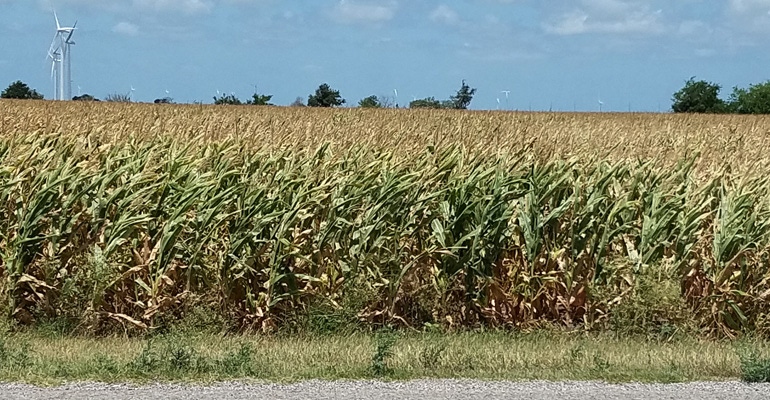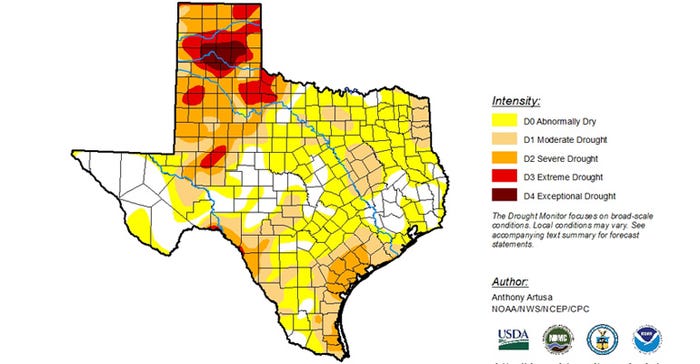June 8, 2018

While no one is throwing in the towel just yet, crop conditions across the South Texas coast are quickly declining because of drought conditions that continue to escalate as summer temperatures begin to simmer.
"This is the driest season we have seen since 2015," reports cotton and grain farmer Wayne Miller of Bluntzer, a farming community just north of Robstown. "It's really good if we can get 8-10 inches of rain between Feb. through August, but this year we are trying to hang on with just over two inches of rain [total]."
He said his crops are desperately in need of 4-5 inches of rain in the days ahead if he hopes to make a crop this year.
Most of Nueces County is under moderate drought conditions. Northeastern areas of the county are at D-2, or severe drought level according to the latest Drought Monitor. Parts of Bee County are in severe drought status, and virtually all of San Patricio, Refugio, Goliad, Victoria, Calhoun, and Jackson counties are experiencing severe drought.

According to the June 5, 2108, Texas Drought Monitor, drought conditions exist over the Corpus Christi Hydrologic Service Area (HSA):
Severe Drought (D2):
Over northern portions of Victoria and Goliad Counties (including the city of Goliad).
Portions of extreme Southeast Bee County, much of Southern and Western Refugio County, a portion of Northern San Patricio County, and a small portion of Western Aransas County.
Portions of Northern Webb County and a portion of Southwestern La Salle County.
Moderate Drought (D1): (outside of D2 areas)
The remainder of Victoria, Goliad, Bee, San Patricio, Aransas, and Refugio Counties.
All of Calhoun and most of Nueces Counties.
Eastern portions of Live Oak County, Northeastern Jim Wells County, and all but western portions of Kleberg County.
Most of Northwestern Webb County, much of Central and Southwestern La Salle County, and a small portion of Western McMullen County.
Abnormally Dry (D0): (outside D1 and D2 areas)
The remainder of Live Oak, Kleberg, La Salle, and McMullen Counties.
All but portions of Northeastern Webb County, all but extreme Southwestern Jim Wells County.
Northern and southwestern portions of Duval County.
"There are some of these [Coastal Bend] counties that received small amounts of rain, but overall most of the Coastal Bend is dry and conditions continue to deteriorate," said Nuecess County Agricultural Agent Jason Ott.
He says crop conditions depend on many variables like tillage methods, seed varieties and scattered rains that may have fallen on one field and failed to fall on others.
"Crops across the county are stressed from lack of soil moisture and rainfall and we are at a critical time when water becomes a serious issue," Ott said. "But while we are seeing some stress in the fields, some crops are doing surprisingly well considering current conditions. We'll make some cotton and grain this year, but it won't be like we have had over the last three years when crop yields and quality were both high."
He said Coastal Bend growers are feeling some pressure from spidermites, which are generally not a problem for local growers. He said farmers are trying to determine the best strategy to deal with them and are prepared to spray fields if thresholds are reached. Also of concern are a few reports of yellow aphids in grain sorghum, but so far sugarcane aphids have not been reported.
"Another problem growers are having in the eastern reaches of the county is related to high winds shortly after planting that caused lodging. Some farmers have replanted, but a lack of moisture has prevented many of those fields from developing well," he said.
The same problem has plagued Lower Rio Grande Valley cotton and grain producers.
Texas AgriLife IPM Specialist Danielle Sekula says during the planting season steady to high winds of 25-30 mph were persistent most of February and well into March. Lodging resulted, especially on fields near the coast. In addition, dry, hot conditions have helped pest populations grow and now that harvest has begun for early-planted grain sorghum, insects are migrating to neighboring cotton fields.
"We're also in need of rain, especially for dryland crops," she noted.
Overall, irrigated acres are doing 'fairly well' according to Sekula, but she says farmers have been consistently irrigating their crops to maintain them. Dryland cotton, on the other hand, is holding its own in some areas and doing very poorly in other parts of the Valley.
"There are cotton farmers down here who are delaying spray applications because plant conditions are so poor on many dryland acres. They don't want to put any more money into a field that isn't going to survive, and insurance adjusters are scheduled to begin work in early July, so some producers are just trying to hold on until then," she adds.
She reports spidermite pressure has been dying down over the last week, but whiteflies still pose a problem near the Rio Grande river along the border. Also, sugarcane aphids are beginning to crop up in some fields in the Mid-Valley. SCA numbers have not been a major problem throughout most of the growing season, but a few grain sorghum fields near Mercedes are showing some signs of sticky build-up on leaves that may soon reach threshold and may require treatment before harvest to prevent clogging of equipment.
Sekula estimates about 25,000 acres of dryland cotton has already been lost to drought across the region this year.
Farmers and ranchers across South Texas are being warned that as a result of the ongoing drought, the threat of wildfires have become a growing concern. According to the Texas Forest Service Burn Ban Map released on June 1, the following counties have instituted official burn bans: Nueces, San Patricio, Aransas, Bee, Victoria and Calhoun. La Salle, Refugio and Kleberg counties continue with their burn bans. No other burn bans are in effect, but more could be coming as above average temperatures and dry conditions continue.
Residents planning on burning should contact county officials to ensure that burning is allowed, and also to see if any restrictions on how and when to burn are in effect. If burning is allowed, be sure it is not done during windy days with low humidity, as this could result in a fire which can easily get out of control.
You May Also Like




